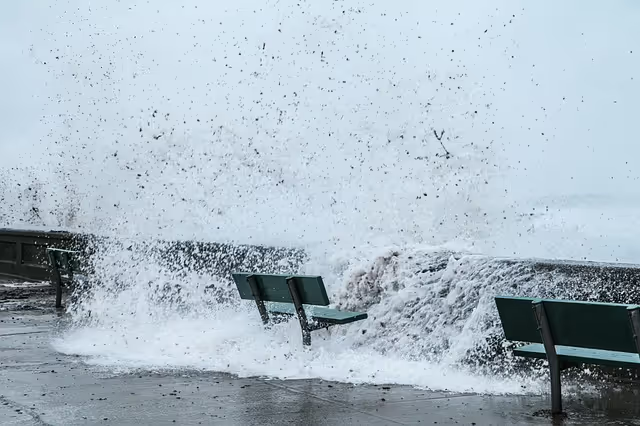King Tides


Nearly every day, there are two low tides and two high tides. Sometimes, the low tides are very low, allowing you to see even more sea creatures and beach treasures than usual on our beloved beaches. At other times, the high tides are very high. This makes it more difficult to see sea creatures or hunt for beach treasures. However, they can produce incredible wave activity, like this.
When the tides get exceptionally high, they become King Tides. King Tide is a general term that people often use to describe these exceptionally high tides. The official term for this phenomenon is Spring Tide, which, on the surface, is a little ironic given that, in our little piece of coastal paradise and elsewhere on the west coast, the King Tides happen in the fall and winter months. However, Spring Tide is actually common historical term that has nothing to do with the Spring season. Instead, the term is derived from the concept of the tide "springing forth" or springing forward. Spring tides occur twice a month, every month, regardless of season. You can think of Spring Tides as being a type of "Ordinary Tides" because they happen so regularly. The standard high and low tides that happen every day as a result of the gravitational pull that occurs between the Earth and the Moon also fit into the "Ordinary Tides" category. King Tides can be thought of as "Special Tides" because they only occur when specific astronomical events increase the power of that pull.
There are two types of King Tides, and each is the result of a different set of astronomical events. One type of king tide starts with a Spring Tide, which occurs when the Earth, Moon, and Sun are in alignment with each other. While the Moon generally has more influence over the Earth’s tides, the Sun also plays its part in "pulling" the ocean back and forth as it "rolls" around the planet. When the Moon and Sun are in alignment with each other, their gravitational effects compound, making the high tides get higher. These already higher-than-normal tides grow even larger when Spring Tides coincide with the Moon when it is in perigee. When the moon is in perigee, it is much close to Earth than usual. Therefore, it's gravitational pull on the ocean is even stronger. The perigee occurs at the same time as a Spring Tide about three to four times a year in both the spring and fall months. This creates the most common type of King Tide, which is officially known as a Perigean Spring Tide.
The other type of King Tide occurs when the Sun is as close to Earth as it is going to get as it completes its annual orbit of the planets that make up our solar system. This position is called perihelion. The Sun reaches this position every year in early January. Similarly, in early July, the Sun is as far away from Earth as it is going to get. This position is known as aphelion. When the Sun is in its aphelion position, its gravitational pull is weakened, which results in smaller tides.
While astronomical events are the main forces that produce King Tides, they aren't the only factors at play. King Tides can grow even higher than they otherwise would in the right weather conditions. If a low-pressure system, which typically brings in the cloudy, rainy conditions that Western Washington is so famous for, moves onshore, then it is possible for higher tides to occur than the ones that were expected. If a low-Pressure system moves onshore during a King Tide, then the King Tide is likely to be higher than expected, which can make for some breathtaking wave action, like this.
On the other hand, high-pressure systems can cause sea levels to drop when they move onshore. Therefore, if one moves through during a King Tide, it is possible to see a lower tide than expected.
The wind can also play a role in making King Tides stronger or weaker. When the wind is blowing from the sea onto land, it is known as an “onshore wind.” This can cause tidal heights to grow considerably because the water starts "piling up" off shore and, like a river, the ocean only has so much space to hold it in. Therefore, if it piles up too far, it spills onto the shoreline. In Ocean Shores, that generally means the beach, although flooding can occur in low lying areas, especially around the North Jetty. Our friends across the harbor in Westport often see flooding in their waterfront business and tourism district when this occurs, especially when its coupled with a King Tide. One of these events occurred a few weeks ago, and you can see a video of it here. https://www.experiencewestport.com/westport-blog/king-tides-in-westport
In the Pacific Northwest, onshore winds are commonly associated with winter storms, and are known as a “storm surge.” However, winds can also be blown away from the shore. This is called an “offshore wind”, and can result in tides that are smaller than expected.

If you want to experience a King Tide in person, you're in luck as King Tide season is underway right now! You can check the tide chart for Ocean Shores here: https://www.tideschart.com/United-States/Washington/Grays-Harbor-County/Ocean-Shores/. Here are some of the upcoming dates when they expect to see King Tides:
References
Edited May 10, 2021 to update several broken links throughout the post. The list of references was also adjusted to replace links with ones that are working correctly when possible.
© Ian D. Caldwell, December 2020
Touch whale bones, examine shipwreck artifacts and connect with the coast's living history.

Support our mission, get involved in educational programs, or contribute through donations and volunteering.